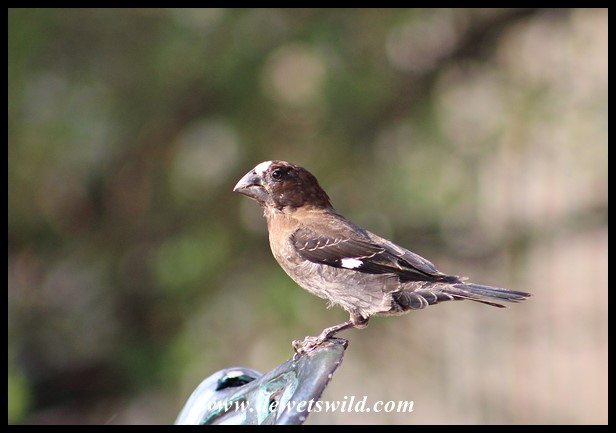Amblyospiza albifrons
During the breeding season, which extends through spring and summer, Thick-billed Weavers can be found near and in marshes and other wetlands with rank grass and reedbeds, but they roam more widely at other times and are then found from forest edges to suburban parks and gardens. They use their strong bills (ask anyone who’s ever handled a Thick-billed Weaver) to good effect feeding on fruit, pips and seeds. They’re one of the largest species of weaver in South Africa, measuring 18cm in length and weighing up to 50g.
The males alone construct the colony of characteristic dome-shaped nests anchored to two or more reeds or thick-stemmed, tall grasses, while the female, if she accepts the nest, will line the inside with soft materials. Males attempt to attract and mate with as many females as possible. The female lays a clutch of 2-4 eggs which she incubates by herself over a two week period. She’s also the sole caretaker to the chicks, which leave the nest about 3 weeks after hatching.
The Thick-billed Weaver has a very patchy distribution over sub-Saharan Africa and the IUCN considers it to be of least concern, siting a common and apparently stable population. In South Africa they’re found in the wetter eastern and northern provinces, and absent from most of the Free State and the Northern and Western Cape. They’ve actually expanded their distribution considerably in recent years due to the availability of suitably vegetated artificial wetlands, like sewerage treatment installations, being constructed.





























Saw a thick billed weaver for the first time here in Kleinemonde, Eastern cape
LikeLike
Always nice to add a new species to the list, isn’t it Trish!?
LikeLike
Their beaks look like our grosbeaks. Those nests are so intricate. It must take them a while to weave.
LikeLiked by 1 person
Amazing to think how they accomplish it so easily!
LikeLiked by 1 person
They really are quite strange looking birds when one thinks about it. I really enjoy seeing those that spend their winters in our garden and surrounds. I assume that in the summer they move back to the wetlands.
LikeLiked by 1 person
I would have bet good money on them finding a suitable winter habitat in your beautiful garden!
LikeLiked by 1 person
Ons het baie ander weavers hier in ons omgewing!
LikeLiked by 1 person
En hulle is almal meester-bouers!
LikeLike
Ja, beslis!
LikeLike
Again, you have not disappointed with your beautifully clear photographs. We must get the odd Thick-billed Weaver in our garden when passing through for I record them only once or twice a year. Even then I see only one or two!
LikeLiked by 1 person
It’s only in the past few years that they’ve moved into urban Gauteng as well, Anne. They seem to love the seeds of the White Stinkwood, which have been planted on the pavements in huge numbers in many Highveld suburbs.
LikeLike
It is the White Stinkwood seeds that attracts them to our garden too, I think.
LikeLiked by 1 person
Lekker stewige nes wat die outjies bou.
LikeLiked by 2 people
Ek stem geheel-en-al saam, dankie Ineke.
LikeLiked by 1 person
A great series of images!
LikeLiked by 1 person
Thank you kindly!
LikeLiked by 1 person